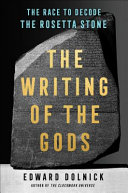2018 School Spending Survey Report
The Writing of the Gods: The Race To Decode the Rosetta Stone
COPY ISBN
VERDICT Dolnick presents a fast-paced intellectual adventure for general readers that surveys the invention of writing and the processes of deciphering and decoding. Highly recommended for anyone who relishes challenging puzzles.
RELATED
ALREADY A SUBSCRIBER? LOG IN
We are currently offering this content for free. Sign up now to activate your personal profile, where you can save articles for future viewing




Comment Policy:
Comment should not be empty !!!